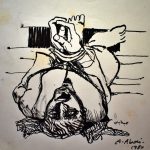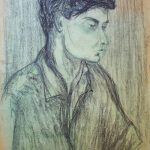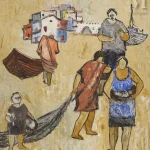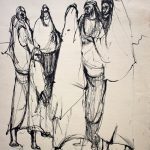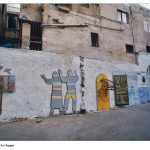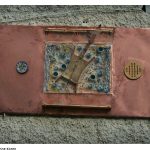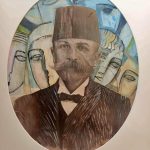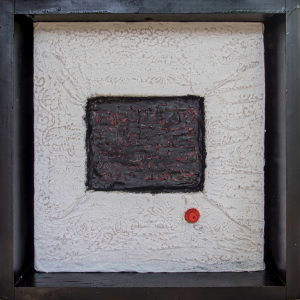
Dr. Ayelet Zohar
The drawer is culturally attached to the concept of secrecy and privacy, the location where one locks personal documents, intimate objects, and cherished secrets. A pictorial instance of this mode of insertion of documents and private objects is Hoogstraten’s image (fig. 25).
This painting was part of the tradition of displaying biographical details9, most common in Dutch still life trompe l’oeil rack paintings of the 17th c., later appearing in the American still life painting tradition of the 19th c.
In both cases, the use of personal objects displayed on a rack (Hoogstraten) or within a drawer (Abdi) achieve a similar goal – the object serves as a metonymy for a personal experience and private secret, a biographical item that the artist wishes to present to the viewer’s gaze and leave enigmatically unexplained.

Gaza, 2008
Shuttered doll and ceramic paste on canvas 80X70X10 cm

Floor tile from Wadi Salib, 2004
Painted tile on plaster and gesso in a wooden
drawer 43X46 cm

Abed Abdi The clock stopped on 22 April 1948, 2012
Clock, Caffiyah, wooden beads and talismans in wooden drawer 34.5X44 cm.
Poetry in the drawer, is indeed, such metaphor. However, in Abdi’s case, the drawers, although holding personal information and images, function as boxes, miniature cubicles where images of the Nakba, family, the passing time and the reminisces of the past are combined with objects of memories of times gone by.
Abdi’s drawers, are displayed upright, poising the drawer as a three-dimensional box that contains varying images and objects. The vertical arrangement displays an option of peeping into, looking at the images as if taken out of concealment, brought out of secrecy to reveal to the viewer the pains and complex feelings Abdi wants to share.
Objects in the drawers range from a tile taken from a deserted house in Wadi Salib neighborhood (fig. 18); talismans of blessing and cure (fig. 19); old calendar, long expired and ticking and still clocks (fig. 20); copper plates, beads, bells, nuts and bolts (fig. 21); images of niqab veiling and window blinds (fig. 22); drift wood and rusted metal pieces, beaten by time and erosion (fig. 23); plaster casts, plastic netting, perforated metal sheets are among the material used to construct the drawers narrative.
Iconography within the drawers bring forward the repetitive image of the blinded window, often used by Abdi in varying contexts: the blinded window is placed on the verge between the outside and inner worlds, yet it conceals the world within to the outside viewer. Simultaneously, the blinded window is also a metonymy for the veiled woman, the one who covers herself not to be seen, but at the same time can watch the world for her hiding position (fig. 22).9 Versus common (Western) belief of the niqab as an oppressive device that devoid women from public presence, Abdi’s work links this position to a possible place of merit and power through the concealed position of the viewer.

Flotsam, 2004
Seashells, rusty iron, keffiyeh fabric, plaster and acrylic in a wooden drawer
45X36.5 cm

Vail, after the Afghan woman, 2011
Aluminum embossment on perforated masonite board within a wooden drawer 41X40 cm

Hidden, 2011
Copper plate, wood and gesso in a drawer 34X54 cm
In another drawer, the pieces of drift metal (fig. 23), taken by the waves carried into seas for decades before being emitted back to shore, serves as a metaphor to Palestinian state of affairs: being taken away, forgotten, drifting from here to there in a rootless condition, then being discharged to shore as worthless, neglected presence.
This is a strong metaphor for the suffering caused by deportation and forgetfulness, but for Abdi, it is also a starting point: he lifts the neglected piece, protects it and cherishes it, then deposits it in one of his drawers and a personal memory and a reminder.
About the author:
Dr. Ayelet Zohar is the curator of Abed Abdi’s exhibition titled “Homage to Lutfia, My Sister in Yarmouk Camp – Paintings and Two-Dimensional Work”. The exhibition is open until the 31st of August 2013 at Beit Hagefen Gallery in Haifa.
| Ayelet Zohar is an artist, independent curator, and visual culture researcher, specializing in the study of photography and contemporary arts in East- Asia. Recently, Zohar curated an homage exhibition to Nam June Paik at the University of Haifa (2013); Smashing!: Fragments and Deconstruction in Contemporary [Ceramic] Arts for the Benyamini Centre of Contemporary Ceramics in Tel Aviv (2012), raising questions concerning the presence of ceramics in the contemporary art field. In 2005 Zohar curated the exhibition PostGender: Gender, Sexuality and Performativity in Contemporary Japanese Art, Tikotin Museum of Japanese Art, addressing questions of sexual identity and gender characteristics in the work of Japan’s leading photographers and video artists. In the current exhibition, Zohar curated Abed Abdi’s work considering the wider context of Palestinian art in Israel, and the tension between the desire for personal-private creation, and the sense of urgency to contribute towards the collective struggle for the identity and status of Palestinian culture in Israel today. In her academic research Zohar published a text on the pictorial language of Ibrahim Nubani, camouflage and invisibility; Zohar also researches the work of Hannah Farah, and its connection to the Kufur Bir’im tragedy in the context of architecture, archaeology and the archive. Recently Zohar has been researching representations of Muslims, Arabs and Palestinians in Japanese art. Zohar is a transdisciplinary artist who graduated from the Midrasha Art School (1986), Central Academy of Fine Art, Beijing (1996), and has a PhD from University of London (2007). She is a trans-media artist, exhibited in numerous one-person and group shows, her works are included in private and public collections in Israel and abroad. |


